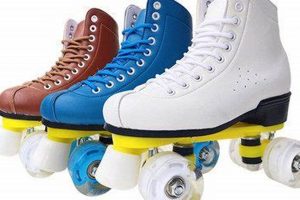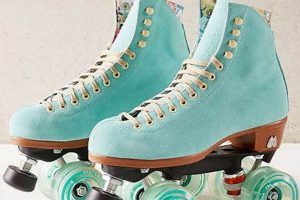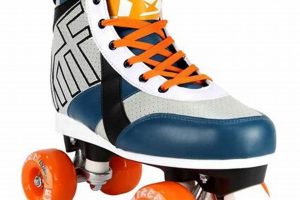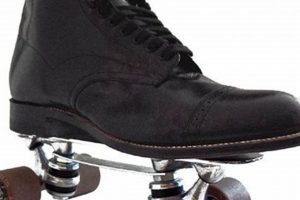Specialized footwear designed for the sport of roller derby is a critical component of an athlete’s equipment. These boots are typically low-cut to allow for maximum ankle mobility, enabling the quick starts, stops, and turns that characterize the game. Often paired with a durable plate and strong wheels, these skates are built to withstand the intense physical demands of the sport.
The right equipment provides advantages in agility, control, and protection. Historically, the evolution of this equipment has mirrored the sport’s growth, adapting to increasing speeds and physicality. Utilizing appropriate gear enables players to execute complex maneuvers, minimize injury risk, and perform at peak levels.
The subsequent sections will explore the specific features and considerations relevant to selecting quality equipment, delving into aspects such as boot construction, plate materials, wheel durometer, and bearing types. Examining these facets is essential for understanding the performance attributes that contribute to success on the track.
Equipment Considerations for Roller Derby
Selecting the appropriate equipment is crucial for performance and safety in roller derby. Prioritize key features and components to optimize experience on the track.
Tip 1: Boot Selection: Opt for a boot that offers a snug, supportive fit without restricting ankle mobility. Leather or synthetic materials reinforced with padding provide a balance of comfort and durability.
Tip 2: Plate Material: Aluminum plates offer superior responsiveness and are lighter than nylon plates, enhancing agility during quick maneuvers. Consider the plate angle relative to the foot for desired turning radius.
Tip 3: Wheel Durometer: Wheel hardness, measured in durometer, affects grip and roll. Softer wheels (lower durometer) provide more grip on slick surfaces, while harder wheels (higher durometer) offer faster roll on smoother tracks. Experiment to find the optimal balance.
Tip 4: Bearing Quality: High-quality bearings reduce friction and improve wheel speed. Sealed bearings require less maintenance and protect against dirt and debris. Regular cleaning and lubrication prolong bearing life.
Tip 5: Toe Stop Adjustment: The toe stop height influences braking power and stability. Adjust toe stops to a comfortable height that allows for controlled stops and quick starts. Regularly inspect toe stops for wear and replace as needed.
Tip 6: Protective Gear: Prioritize safety by wearing a helmet, mouthguard, elbow pads, knee pads, and wrist guards. Ensure that protective gear fits properly and meets safety standards.
Selecting the correct components enhances agility, reduces risk of injury, and improves overall performance on the track. Careful consideration of boot fit, plate material, wheel characteristics, bearing quality, and protective gear are vital.
The following sections will detail maintenance procedures to prolong the lifespan of equipment and ensure optimal performance.
1. Boot Fit
Boot fit is paramount when selecting equipment for roller derby. The connection between the foot and the skate dictates control, power transfer, and ultimately, the skater’s performance and safety on the track. Improper boot fit can lead to discomfort, decreased agility, and increased risk of injury.
- Ankle Support and Mobility
Proper ankle support is critical to prevent sprains and strains, which are common in the dynamic movements of roller derby. A boot that extends adequately up the ankle provides the necessary stability for lateral movements and quick pivots. However, the boot must also allow for sufficient ankle flexion and extension to execute maneuvers effectively. Striking the right balance between support and mobility is essential.
- Snugness and Comfort
The boot should fit snugly around the foot without causing pressure points or restricting circulation. Excess space within the boot can lead to slippage, reduced responsiveness, and blisters. Heat-moldable boots can be custom-fitted to the skater’s foot, providing a personalized fit and enhancing comfort. Lacing systems play a role in securing the foot, with options ranging from traditional laces to ratcheting buckle systems, each offering different levels of adjustability and support.
- Material and Construction
The material and construction of the boot affect its durability, breathability, and weight. Leather boots offer a classic feel and conform to the foot over time, but may require a longer break-in period. Synthetic materials are often lighter and more resistant to moisture, but may not offer the same level of breathability as leather. Reinforced stitching and durable outsoles are important for withstanding the rigors of roller derby.
- Impact Absorption
Roller derby involves frequent impacts and collisions. Boots designed with integrated padding and shock-absorbing materials can mitigate the force of these impacts, reducing the risk of foot and ankle injuries. Look for boots with strategically placed padding in areas prone to impact, such as the ankle bones and the ball of the foot.
In conclusion, prioritizing boot fit is a fundamental aspect of selecting roller derby equipment. The interplay between ankle support, snugness, material, and impact absorption directly affects a skater’s ability to perform safely and effectively. Skaters are advised to seek professional fitting and consult with experienced derby players to determine the best boot for their individual needs and skating style.
2. Plate Material
The material composition of the plate, the chassis connecting the wheels to the boot of the skate, is a critical determinant of a roller derby skaters performance. This component directly influences responsiveness, stability, and overall skate weight, impacting maneuverability and endurance on the track.
- Aluminum Alloys
Aluminum alloys are commonly employed due to their favorable strength-to-weight ratio. Different alloys offer varying degrees of stiffness and durability. Higher-grade aluminum, such as 7075, provides enhanced resistance to deformation under stress, improving power transfer during pushes and turns. This translates to quicker acceleration and more precise control.
- Nylon Composites
Nylon plates, often reinforced with fiberglass or carbon fiber, provide a more flexible and forgiving feel. They are typically lighter and less expensive than aluminum options, making them suitable for beginners or skaters prioritizing comfort over ultimate performance. However, the reduced stiffness can result in less direct energy transfer and reduced responsiveness.
- Plate Length and Mounting
The length of the plate and its mounting position relative to the boot influences the skate’s turning radius and stability. Shorter plates offer increased agility and quicker turning, while longer plates provide greater stability at higher speeds. Proper plate mounting is essential for balanced weight distribution and optimal performance.
- Kingpin Angle
The kingpin angle, the inclination of the bolt that connects the trucks to the plate, affects the skate’s turning responsiveness. Steeper kingpin angles result in more agile turning, while shallower angles provide greater stability. Adjusting the kingpin angle, often referred to as “tuning” the skate, allows skaters to customize their equipment to their skating style and the specific demands of the track.
The selection of plate material represents a crucial decision in assembling roller derby skates. Consideration of factors such as weight, stiffness, plate geometry, and kingpin angle should align with the skater’s skill level, skating style, and the intended application. An informed choice directly translates to enhanced performance and a more enjoyable skating experience.
3. Wheel Durometer
Wheel durometer, a measure of wheel hardness, is a critical specification influencing the performance characteristics of roller derby skates. Expressed on the A scale, durometer dictates the wheel’s grip, roll speed, and overall suitability for various track surfaces and skating styles.
- Grip and Traction
Lower durometer wheels (e.g., 88A-92A) possess increased grip and traction, particularly advantageous on slick surfaces or when executing sharp turns. The softer compound deforms more readily, increasing the contact area with the track and enhancing adhesion. This characteristic benefits blockers requiring stability and controlled movements.
- Roll Speed and Momentum
Higher durometer wheels (e.g., 97A-101A) offer reduced rolling resistance, resulting in faster speeds and improved momentum. The harder compound maintains its shape under load, minimizing energy loss during each rotation. This attribute is favored by jammers prioritizing speed and agility for navigating the pack.
- Surface Considerations
Track surface significantly influences optimal durometer selection. Smooth, polished surfaces favor harder wheels, maximizing roll speed. Conversely, rougher or more textured surfaces necessitate softer wheels to maintain adequate grip. The specific conditions of a venue should inform equipment choices.
- Skating Style and Preference
Individual skating style and preferences play a crucial role in determining the ideal durometer. Some skaters prioritize maneuverability and control, while others seek maximum speed. Experimentation with different durometers allows skaters to fine-tune their equipment to match their unique requirements and enhance their performance.
Ultimately, the selection of wheel durometer represents a trade-off between grip and roll speed. Experienced roller derby skaters often maintain multiple sets of wheels with varying durometers to adapt to diverse track conditions and strategic roles within the game. Careful consideration of surface characteristics, skating style, and individual preferences is essential for optimizing performance.
4. Bearing Precision
Bearing precision is a critical factor influencing the performance of roller derby skates. Bearings, the components facilitating wheel rotation around the axle, directly affect the speed, efficiency, and smoothness of the skater’s movement. The precision to which these bearings are manufactured significantly impacts their functionality and longevity.
- ABEC Rating and Tolerances
The Annular Bearing Engineering Committee (ABEC) rating system defines the manufacturing tolerances of bearings. Higher ABEC ratings (e.g., ABEC 7, ABEC 9) indicate tighter tolerances and greater precision in the bearing’s construction. Bearings with higher ABEC ratings generally exhibit reduced friction, leading to increased roll speed and smoother operation. However, the ABEC rating primarily addresses dimensional accuracy and does not encompass all aspects of bearing quality.
- Material Composition and Hardness
The materials used in bearing construction, such as steel alloys or ceramic hybrids, influence durability and resistance to wear. Harder materials, often treated with specialized coatings, withstand greater stress and maintain their shape under load. The hardness of the bearing races and balls contributes to their ability to resist deformation and maintain consistent performance over time. Ceramic bearings, while more expensive, offer superior hardness, reduced friction, and improved resistance to heat, making them advantageous in high-demand applications.
- Lubrication and Maintenance
Proper lubrication is essential for minimizing friction and preventing corrosion within the bearing assembly. Specialized lubricants designed for skating applications reduce friction, dissipate heat, and protect against contaminants. Regular cleaning and lubrication are crucial for maintaining optimal bearing performance and extending their lifespan. Neglecting maintenance can lead to increased friction, reduced speed, and premature bearing failure.
- Impact Resistance and Durability
Roller derby skates are subjected to significant impact forces and lateral loads. Bearings must be capable of withstanding these stresses without deformation or failure. Reinforced bearing cages and robust sealing mechanisms enhance impact resistance and protect against contamination from dirt and debris. Durability is a key consideration for bearings used in roller derby, where the equipment is subjected to demanding conditions.
In summary, bearing precision encompasses several factors, including manufacturing tolerances, material composition, lubrication, and impact resistance. Selecting high-quality bearings with appropriate precision is crucial for optimizing the performance of roller derby skates. Regular maintenance and proper lubrication further contribute to bearing longevity and consistent performance throughout the skate’s lifespan.
5. Toe Stop Design
Toe stop design is a crucial element impacting the functionality and safety of roller derby skates. This component, situated at the front of the skate, serves as a primary braking mechanism and a pivotal point for specific maneuvers. The geometry, material composition, and adjustability of the toe stop directly influence a skater’s ability to control speed, execute controlled stops, and maintain balance during gameplay. The design affects the skaters stability and agility on the track.
Different toe stop designs offer varied advantages. Larger surface areas provide increased stopping power and stability but may impede agility. Smaller, more streamlined designs allow for greater maneuverability and reduced weight but may compromise stopping efficiency. Materials such as natural rubber, synthetic compounds, and composite blends affect the grip and durability of the toe stop. Adjustable toe stops permit customization of height and angle, adapting to individual skating styles and preferences. For example, a blocker might favor larger toe stops for stability in defensive positions, whereas a jammer might opt for smaller stops to facilitate quick transitions and dodging.
Effective use of toe stops requires proper technique and understanding of their mechanical properties. Improper adjustment or reliance on worn toe stops can lead to decreased control and increased risk of falls or collisions. Therefore, careful consideration of toe stop design and regular maintenance are vital for maximizing safety and performance in roller derby. The selection should align with the skater’s experience level and position within the sport to ensure appropriate functionality.
Frequently Asked Questions
This section addresses common inquiries regarding specialized footwear used in roller derby. Understanding the nuances of this equipment is crucial for both novice and experienced athletes.
Question 1: What distinguishes roller derby skates from recreational models?
Roller derby skates are engineered for the unique demands of the sport. They prioritize agility, responsiveness, and durability over comfort-oriented features found in recreational skates. Low-cut boots, robust plates, and specialized wheels are common differentiators.
Question 2: How often should roller derby skates be replaced?
The lifespan of roller derby skates depends on usage frequency, intensity, and maintenance. Components like wheels and toe stops require periodic replacement due to wear. Boots and plates may last longer but should be assessed regularly for structural integrity.
Question 3: Can any type of wheels be used on roller derby skates?
While technically possible, using inappropriate wheels can compromise performance and safety. Roller derby wheels are typically high-rebound urethane, designed for the specific track conditions and maneuvers involved in the sport. Using wheels intended for outdoor skating or other disciplines is not recommended.
Question 4: What maintenance is required for roller derby skates?
Regular maintenance includes cleaning and lubricating bearings, inspecting wheels for wear, ensuring toe stops are securely attached, and checking for any loose hardware. Promptly addressing any issues prevents further damage and prolongs the life of the equipment.
Question 5: Are roller derby skates suitable for other skating disciplines?
The specialized design of roller derby skates makes them less suitable for other skating disciplines like artistic skating or speed skating. The focus on agility and maneuverability may not translate well to the sustained speed or intricate footwork required in other sports.
Question 6: What is the significance of the plate material in roller derby skates?
The plate material significantly impacts the skate’s responsiveness and overall weight. Aluminum plates offer greater stiffness and energy transfer, while nylon plates provide more flexibility and affordability. The choice of plate material should align with the skater’s skill level and performance goals.
Choosing the appropriate roller derby skates and maintaining them diligently is essential for a safe and effective athletic experience.
The following section provides resources for further research on equipment selection and maintenance.
Conclusion
This exploration has detailed the critical components of roller derby skates and the performance implications of each selection. From boot fit and plate material to wheel durometer, bearing precision, and toe stop design, each element contributes significantly to the athlete’s control, agility, and safety. Choosing the appropriate equipment and adhering to a consistent maintenance schedule are integral to competitive success and injury prevention.
A thorough understanding of equipment specifications and their corresponding effects on skating dynamics is paramount for participants in roller derby. The information presented serves as a foundation for informed decision-making, empowering athletes to optimize their performance and maximize their potential within this demanding and dynamic sport. Continued research and practical application of this knowledge are encouraged to further refine equipment choices and advance the sport’s competitive landscape.







